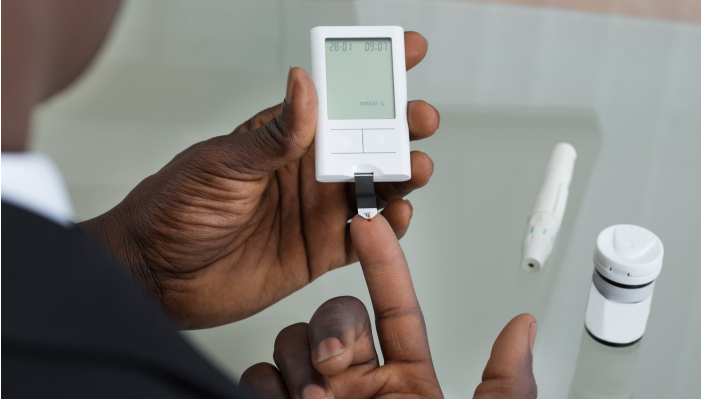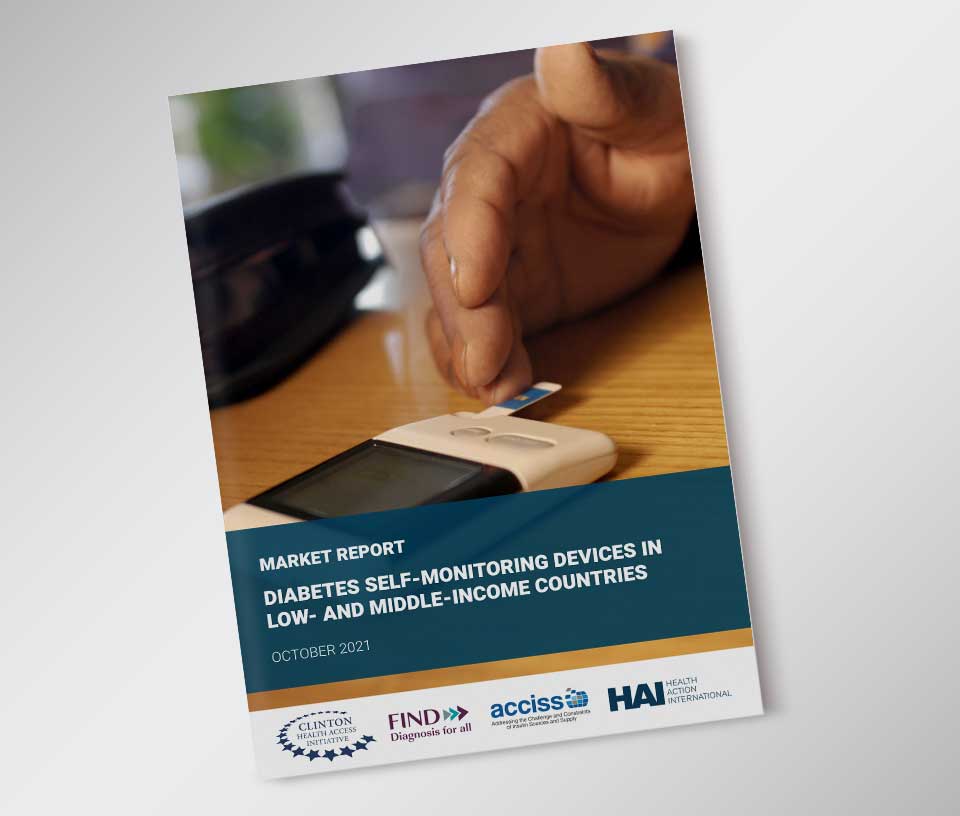The report is the first of its kind providing market intelligence on the current state of access to blood glucose self-monitoring devices in low- and middle-income countries. It was published by CHAI, Health Action International, and FIND, the global alliance for diagnostics
Download the report Download factsheet
Diabetes is a common, chronic non-communicable disease, characterized by the body’s inability to regulate glucose, or blood sugar. The number of people living with diabetes was over 463 million in 2019, and is increasing rapidly, particularly in low- and middle-income countries which already account for over three-quarters of the global diabetes burden.
To avoid severe and life-threatening outcomes, all people with type 1 diabetes and many people with type 2 diabetes require daily, lifelong treatment, such insulin (for type 1 and some type 2) as well as glucose self-monitoring devices that routinely track glucose levels to inform adjustments in treatment dosages, and prevent dangerous fluctuations in glucose levels. Glucose self-monitoring is an integral component of diabetes management.
Historically, the debate about access to diabetes treatment has centered around access to insulin. Glucose self-monitoring devices, meanwhile, have received minimal attention despite their essential role in diabetes management, and coupled with other barriers, access to such devices is limited for people living with diabetes in low- and middle-income countries. Key access challenges include: the high cost of the devices and their scarce availability in the public sector. Additional investment is needed in low- and middle-income countries to increase access to glucose self-monitoring devices.
“Kyrgyzstan is a lower middle income country where access to glucose monitoring is compromised by many challenges,” said Aigerim Zhaparova, ACCISS Program Coordinator, Kyrgyzstan. “These include the poor allocation of resources in the healthcare system, aggressive marketing strategies of manufacturers, especially aimed at unaware customer base, and the discrepancy in cheap/free glucose monitoring meters and expensive test strips. It is important to address these issues, so the access to vital glucose monitoring is accessible and affordable.”

Example of a basic self-monitoring blood glucose device, which uses a small blood sample to produce a point-of-care reading of an individual’s blood glucose level.
To help advance insights into market-related barriers preventing access to glucose monitoring, CHAI partnered with Health Access International and FIND to develop a report on the global glucose self-monitoring device market. In addition to promoting market transparency, the report describes the barriers−global, national, and individual−which hinder access to the devices in low- and middle-income countries and proposes recommendations to improve market dynamics and health outcomes in these countries.
Key highlights from the report include:
- Market sizing and growth estimates by geographic region: The total market for glucose self-monitoring devices is estimated to be worth approximately US$12 billion and growing rapidly at a compound annual growth rate of between 8−13 percent. Data indicate that market growth will occur primarily in low- and middle-income countries where unmet need is high and disease burden is projected to increase significantly in the coming decades.
- Product and supplier landscape: First, there is no international guidance on target product specifications for self-glucose monitoring devices for low- and middle-income markets. As a result, there are a wide range of products and suppliers on the market—including ones that do not meet stringent regulatory authority requirements or the needs of people with diabetes. Second, despite a diversity of suppliers, the market is highly concentrated, with a handful of U.S.- or Swiss-based multinational companies holding an estimated 80 percent of the global market share. Third, the low- and middle-income country market is expected to gradually shift to favor the newer, more differentiated, and technologically advanced product class of continuous glucose monitoring (CGM) devices, which are more common in high-income countries, high priced, and only manufactured by a few suppliers.
- Supplier sales strategies: To maintain market share, there is no interoperability between suppliers’ products. While the largest suppliers rely on brand recognition, demonstrated quality, and established production and distribution networks to sustain sales in low- and middle-income countries, emerging and smaller suppliers must compete heavily on pricing and conduct direct-to-consumer campaigns with product giveaways to attract new customers.
- Product cost and pricing trends: Data indicate the cost to consumers for glucose self-monitoring devices is prohibitively expensive and a major barrier to access (ranging between US$98 and US$2,600 per person per year). The annual cost is driven by suppliers setting high prices for product components that are frequently replaced, as well as high markups along the supply chain.
- Product access points: The absence of donor funding and limited public financing for product procurement and supply results in glucose self-monitoring devices being accessed primarily in private pharmacies as opposed to public health clinics. As a result, people living with diabetes are unable to purchase the devices and do not have easy access to comprehensive health education to manage their condition.
To generate market conditions that would enable widespread and equitable access to glucose self-monitoring devices in low- and middle-income countries, the report proposes a mix of interventions, including:
- Advocating for bilateral donor support for glucose self-monitoring,
- Developing a target product profile for devices appropriate for low and middle-income settings,
- Improving market transparency, both on the demand and supply side,
- Establishing access price agreements with suppliers,
- Exploring alternative procurement channels, such as coordinated procurement across multiple countries,
- Including glucose self-monitoring devices in national health insurance plans,
- Strengthening overall diabetes care, and
- Conducting additional research to fill key evidence gaps.
Ultimately, the report is a critical step towards understanding the type and magnitude of investment needed to meaningfully shape the glucose self-monitoring device market and significantly improve health outcomes for people living with diabetes in low- and middle-income countries.






